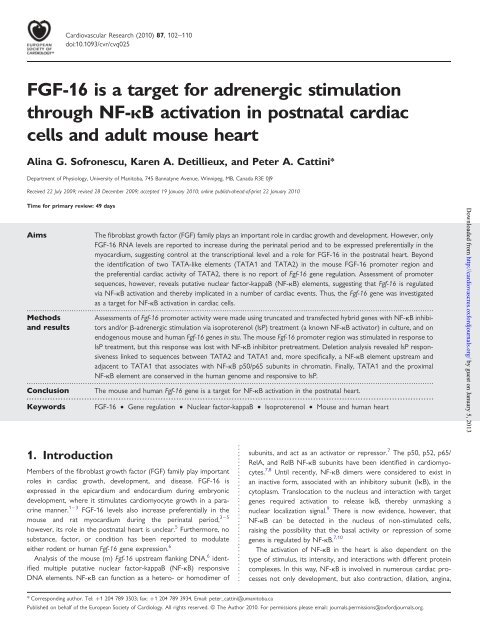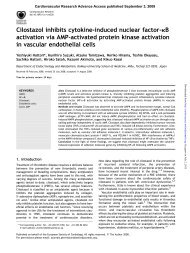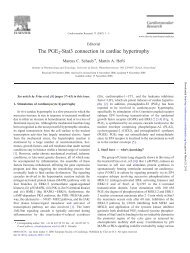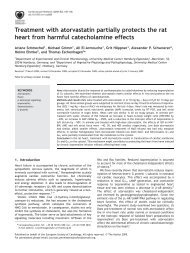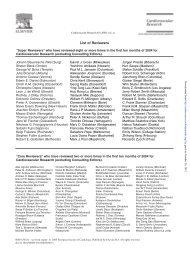FGF-16 is a target for adrenergic stimulation through NF-kB ...
FGF-16 is a target for adrenergic stimulation through NF-kB ...
FGF-16 is a target for adrenergic stimulation through NF-kB ...
You also want an ePaper? Increase the reach of your titles
YUMPU automatically turns print PDFs into web optimized ePapers that Google loves.
Cardiovascular Research (2010) 87, 102–110<br />
doi:10.1093/cvr/cvq025<br />
<strong>FGF</strong>-<strong>16</strong> <strong>is</strong> a <strong>target</strong> <strong>for</strong> <strong>adrenergic</strong> <strong>stimulation</strong><br />
<strong>through</strong> <strong>NF</strong>-<strong>kB</strong> activation in postnatal cardiac<br />
cells and adult mouse heart<br />
Alina G. Sofronescu, Karen A. Detillieux, and Peter A. Cattini*<br />
Department of Physiology, University of Manitoba, 745 Bannatyne Avenue, Winnipeg, MB, Canada R3E 0J9<br />
Received 22 July 2009; rev<strong>is</strong>ed 28 December 2009; accepted 19 January 2010; online publ<strong>is</strong>h-ahead-of-print 22 January 2010<br />
Time <strong>for</strong> primary review: 49 days<br />
Aims The fibroblast growth factor (<strong>FGF</strong>) family plays an important role in cardiac growth and development. However, only<br />
<strong>FGF</strong>-<strong>16</strong> RNA levels are reported to increase during the perinatal period and to be expressed preferentially in the<br />
myocardium, suggesting control at the transcriptional level and a role <strong>for</strong> <strong>FGF</strong>-<strong>16</strong> in the postnatal heart. Beyond<br />
the identification of two TATA-like elements (TATA1 and TATA2) in the mouse <strong>FGF</strong>-<strong>16</strong> promoter region and<br />
the preferential cardiac activity of TATA2, there <strong>is</strong> no report of Fgf-<strong>16</strong> gene regulation. Assessment of promoter<br />
sequences, however, reveals putative nuclear factor-kappaB (<strong>NF</strong>-<strong>kB</strong>) elements, suggesting that Fgf-<strong>16</strong> <strong>is</strong> regulated<br />
via <strong>NF</strong>-<strong>kB</strong> activation and thereby implicated in a number of cardiac events. Thus, the Fgf-<strong>16</strong> gene was investigated<br />
as a <strong>target</strong> <strong>for</strong> <strong>NF</strong>-<strong>kB</strong> activation in cardiac cells.<br />
.....................................................................................................................................................................................<br />
Methods Assessments of Fgf-<strong>16</strong> promoter activity were made using truncated and transfected hybrid genes with <strong>NF</strong>-<strong>kB</strong> inhibi-<br />
and results tors and/or b-<strong>adrenergic</strong> <strong>stimulation</strong> via <strong>is</strong>oproterenol (IsP) treatment (a known <strong>NF</strong>-<strong>kB</strong> activator) in culture, and on<br />
endogenous mouse and human Fgf-<strong>16</strong> genes in situ. The mouse Fgf-<strong>16</strong> promoter region was stimulated in response to<br />
IsP treatment, but th<strong>is</strong> response was lost with <strong>NF</strong>-<strong>kB</strong> inhibitor pretreatment. Deletion analys<strong>is</strong> revealed IsP responsiveness<br />
linked to sequences between TATA2 and TATA1 and, more specifically, a <strong>NF</strong>-<strong>kB</strong> element upstream and<br />
adjacent to TATA1 that associates with <strong>NF</strong>-<strong>kB</strong> p50/p65 subunits in chromatin. Finally, TATA1 and the proximal<br />
<strong>NF</strong>-<strong>kB</strong> element are conserved in the human genome and responsive to IsP.<br />
.....................................................................................................................................................................................<br />
Conclusion The mouse and human Fgf-<strong>16</strong> gene <strong>is</strong> a <strong>target</strong> <strong>for</strong> <strong>NF</strong>-<strong>kB</strong> activation in the postnatal heart.<br />
-----------------------------------------------------------------------------------------------------------------------------------------------------------<br />
Keywords <strong>FGF</strong>-<strong>16</strong> † Gene regulation † Nuclear factor-kappaB † Isoproterenol † Mouse and human heart<br />
1. Introduction<br />
Members of the fibroblast growth factor (<strong>FGF</strong>) family play important<br />
roles in cardiac growth, development, and d<strong>is</strong>ease. <strong>FGF</strong>-<strong>16</strong> <strong>is</strong><br />
expressed in the epicardium and endocardium during embryonic<br />
development, where it stimulates cardiomyocyte growth in a paracrine<br />
manner. 1 – 3 <strong>FGF</strong>-<strong>16</strong> levels also increase preferentially in the<br />
3 – 5<br />
mouse and rat myocardium during the perinatal period,<br />
however, its role in the postnatal heart <strong>is</strong> unclear. 5 Furthermore, no<br />
substance, factor, or condition has been reported to modulate<br />
either rodent or human Fgf-<strong>16</strong> gene expression. 6<br />
Analys<strong>is</strong> of the mouse (m) Fgf-<strong>16</strong> upstream flanking DNA, 6 identified<br />
multiple putative nuclear factor-kappaB (<strong>NF</strong>-<strong>kB</strong>) responsive<br />
DNA elements. <strong>NF</strong>-<strong>kB</strong> can function as a hetero- or homodimer of<br />
subunits, and act as an activator or repressor. 7 The p50, p52, p65/<br />
RelA, and RelB <strong>NF</strong>-<strong>kB</strong> subunits have been identified in cardiomyocytes.<br />
7,8 Until recently, <strong>NF</strong>-<strong>kB</strong> dimers were considered to ex<strong>is</strong>t in<br />
an inactive <strong>for</strong>m, associated with an inhibitory subunit (I<strong>kB</strong>), in the<br />
cytoplasm. Translocation to the nucleus and interaction with <strong>target</strong><br />
genes required activation to release I<strong>kB</strong>, thereby unmasking a<br />
nuclear localization signal. 9 There <strong>is</strong> now evidence, however, that<br />
<strong>NF</strong>-<strong>kB</strong> can be detected in the nucleus of non-stimulated cells,<br />
ra<strong>is</strong>ing the possibility that the basal activity or repression of some<br />
genes <strong>is</strong> regulated by <strong>NF</strong>-<strong>kB</strong>. 7,10<br />
The activation of <strong>NF</strong>-<strong>kB</strong> in the heart <strong>is</strong> also dependent on the<br />
type of stimulus, its intensity, and interactions with different protein<br />
complexes. In th<strong>is</strong> way, <strong>NF</strong>-<strong>kB</strong> <strong>is</strong> involved in numerous cardiac processes<br />
not only development, but also contraction, dilation, angina,<br />
* Corresponding author. Tel: þ1 204 789 3503; fax: þ1 204 789 3934, Email: peter_cattini@umanitoba.ca<br />
Publ<strong>is</strong>hed on behalf of the European Society of Cardiology. All rights reserved. & The Author 2010. For perm<strong>is</strong>sions please email: journals.perm<strong>is</strong>sions@ox<strong>for</strong>djournals.org.<br />
Downloaded from<br />
http://cardiovascres.ox<strong>for</strong>djournals.org/ by guest on January 5, 2013
<strong>FGF</strong>-<strong>16</strong> <strong>is</strong> a <strong>target</strong> <strong>for</strong> <strong>NF</strong>-<strong>kB</strong> activation 103<br />
atheroscleros<strong>is</strong>, inflammation, <strong>is</strong>chaemia, hypertrophy, and heart<br />
failure. 7,11 A role <strong>for</strong> <strong>FGF</strong>-<strong>16</strong> has been suggested under pathological<br />
conditions in the heart. 3 Thus, we investigated the possibility that<br />
<strong>FGF</strong>-<strong>16</strong> <strong>is</strong> a <strong>target</strong> <strong>for</strong> <strong>NF</strong>-<strong>kB</strong> in postnatal cardiac cells, <strong>through</strong> the<br />
use of tumour necros<strong>is</strong> factor alpha (T<strong>NF</strong>-a) and b-<strong>adrenergic</strong><br />
<strong>stimulation</strong>, which are known to activate <strong>NF</strong>-<strong>kB</strong>. 12,13 We show that<br />
mouse Fgf-<strong>16</strong> RNA expression <strong>is</strong> responsive to <strong>NF</strong>-<strong>kB</strong> activation<br />
and <strong>is</strong> linked to sequences located between two <strong>FGF</strong>-<strong>16</strong> TATA/<br />
promoter regions. The downstream promoter region <strong>is</strong> conserved<br />
in the human genome, which <strong>is</strong> also responsive to <strong>NF</strong>-<strong>kB</strong><br />
activation in transfected rat cardiomyocytes. The implications of<br />
these data are d<strong>is</strong>cussed in relation to regulation of Fgf-<strong>16</strong> gene<br />
expression and possible functional roles <strong>for</strong> <strong>FGF</strong>-<strong>16</strong> in the postnatal<br />
myocardium.<br />
2. Methods<br />
2.1 Cultures/gene transfer<br />
All procedures involving animals, their t<strong>is</strong>sues and cells con<strong>for</strong>m to the<br />
Guide <strong>for</strong> the Care and Use of Laboratory Animals publ<strong>is</strong>hed by the<br />
US National Institutes of Health (NIH Publication No. 85-23, rev<strong>is</strong>ed<br />
1996). Ventricular myocytes were <strong>is</strong>olated from 1-day-old rat hearts<br />
(36–40) using enzymatic digestion and Percoll gradient fractionation as<br />
previously described. 6 Cells were transfected using calcium phosphate/<br />
DNA precipitation 24 h after plating as previously described, 6,14 using<br />
10 mg test plasmid per plate with 20 ng TKp.Rluc (encoding Renilla luciferase)<br />
to correct <strong>for</strong> variations in transfection efficiency.<br />
For T<strong>NF</strong>-a treatment, cells were cultured in high glucose Dulbecco’s<br />
modified Eagle’s medium (DMEM) and antibiotics, without serum and<br />
the presence or absence of 25 ng/mL recombinant rat T<strong>NF</strong>-a (Biosource,<br />
Camarillo, CA, USA). 13 For <strong>is</strong>oproterenol (IsP) treatment, myocytes were<br />
cultured in DMEM with 10% foetal bovine serum (FBS), in the presence or<br />
absence of 10 mM IsP (Sigma-Aldrich, Oakville, ON, Canada). 15 Inhibition<br />
of <strong>NF</strong>-<strong>kB</strong> activation was done as reported. <strong>16</strong>,17 Briefly, cells were preincubated<br />
<strong>for</strong> 1 h with 100 mM pyrrolidine dithiocarbamate (PDTC) or<br />
1.5 h with 10 mM N-(6-chloro-9H-b-carbolin-8-yl) nicotinamide<br />
(PS-1145) in 10% FBS-DMEM, be<strong>for</strong>e IsP addition <strong>for</strong> 6 h. Cells were<br />
then collected in 100 mM Tr<strong>is</strong>, 0.1% Triton X-100 and assessed by a<br />
Dual Luciferase Assay System (Promega, Mad<strong>is</strong>on, WI, USA).<br />
2.2 Hybrid <strong>FGF</strong>-<strong>16</strong>/luciferase genes<br />
Generation of 24.7/þ1.1, 24.7, 22.7, 21.2, 20.2 m<strong>FGF</strong>-<strong>16</strong>p.luc genes<br />
was described previously, 6 but are renamed here 25771/212,<br />
25771/21039, 23773/21039, 22309/21039, and 21268/21039<br />
m<strong>FGF</strong>-<strong>16</strong>p.luc based on assigning the adenosine residue in the methionine<br />
translation start site nucleotide position þ1. The 21292/230<br />
m<strong>FGF</strong>-<strong>16</strong>p.luc gene was generated by polymerase chain reaction (PCR)<br />
amplification of the 21292/230 m<strong>FGF</strong>-<strong>16</strong> fragment (Table 1) and insertion<br />
directly into the promoterless reporter gene vector -p.luc. The<br />
21292/2760 and 21292/2627 m<strong>FGF</strong>-<strong>16</strong>p.luc constructs were generated<br />
by the digestion of 21292/230 m<strong>FGF</strong>-<strong>16</strong>p.luc construct with SacI<br />
and BglI, respectively, and the 2747/212 m<strong>FGF</strong>-<strong>16</strong>p.luc construct was<br />
generated by SacI/KpnI digestion of 25771/212 m<strong>FGF</strong>-<strong>16</strong>p.luc construct,<br />
all followed by religation. The human (h) 2737/21 h<strong>FGF</strong>-<strong>16</strong>p.luc construct<br />
was obtained <strong>through</strong> PCR amplification of the 2737/21<br />
h<strong>FGF</strong>-<strong>16</strong> fragment (Table 1) from human placenta DNA (DNeasey<br />
Blood & T<strong>is</strong>sue Kit, Qiagen, ON, Canada), and insertion into -p.luc.<br />
2.3 DNA sequencing<br />
Genomic DNA from human placenta and blood was <strong>is</strong>olated using the<br />
DNeasy Blood and T<strong>is</strong>sue Kit (Qiagen). Collection and manipulation of<br />
all human t<strong>is</strong>sue con<strong>for</strong>ms to the principles outlined in the Declaration<br />
Table 1 Primers used <strong>for</strong> PCR<br />
Primer name Sequence<br />
....................................................................................<br />
h<strong>FGF</strong>-<strong>16</strong> exon 1/2 5<br />
junction F<br />
0-ACAGCCGCTTCGGAATCC-30 h<strong>FGF</strong>-<strong>16</strong> exon 2 R 5 0 -CCTCGCTCATTCATTCCTAGGT-3 0<br />
2879 h<strong>FGF</strong>-<strong>16</strong> F 50-CCCCGCCAACCTATACAGGTA-30 2794 h<strong>FGF</strong>-<strong>16</strong> R 50-TCGGAGGCTGCGGAAAG-30 2310 h<strong>FGF</strong>-<strong>16</strong> F 50-AAAGTGCCGTTTGCATCTGAT-30 2230 h<strong>FGF</strong>-<strong>16</strong> R 50-TCCTGACCTTGCTCTCAGTCAA-30 Sequencing primers h<strong>FGF</strong>-<strong>16</strong><br />
2892 h<strong>FGF</strong>-<strong>16</strong> F 50-CACTTCCTCGGTACCCCG-30 2385 h<strong>FGF</strong>-<strong>16</strong> R 50-CACACCTCATTGGCATCCCCTC-30 22035 h<strong>FGF</strong>-<strong>16</strong> F 50-CCCCTCACCCAGCTTAAC-30 21427 h<strong>FGF</strong>-<strong>16</strong> R 50-CCCTGGCACTCGGCGTCCCG-30 2490 h<strong>FGF</strong>-<strong>16</strong> R 50-AGAGGGAGTGAAGCTCG-30 2735 h<strong>FGF</strong>-<strong>16</strong> F 50-CCAACTCCCGTCTCGAGG CACTTTCCA-30 2735 h<strong>FGF</strong>-<strong>16</strong> R 50-CTGGGCCGATTGCGG-30 mB2m F 50-GCTATCCAGAAAACCCCTCAAA-30 mB2m R 50-GCGGGTGGAACTGTGTTACG-30 50-ACAGCCGCTTCGGAATTCT-30 m<strong>FGF</strong>-<strong>16</strong> exon 1/2<br />
junction F<br />
m<strong>FGF</strong>-<strong>16</strong> exon 2 R 5 0 -CTCTCCTCGCTCATTCATTCCT-3 0<br />
21292/230 m<strong>FGF</strong>-<strong>16</strong> F 50-CCCCCGGTACCCGCCAGTTCCC ACCCCTG-30 21292/230 m<strong>FGF</strong>-<strong>16</strong> R 50-CCCCCGGTACCGGGCCGAG CCGGGGCC-30 h<strong>FGF</strong>-<strong>16</strong> UTP F 50-ACCCCGCCAACCTATACA-30 h<strong>FGF</strong>-<strong>16</strong> DTP F 50-GAGCAAGGTCAGGAGCACG-30 50-ACAGCCGCTTCGGAATCC-30 h<strong>FGF</strong>-<strong>16</strong> exon 1/2<br />
junction F<br />
h<strong>FGF</strong>-<strong>16</strong> exon 2 R 50-CCTCGCTCATTCATTCCT-30 hGAPDH F 50-CCATGGAGAAGGCTGGGG-30 hGAPDH R 50-CAAAGTTGTCATGGATGACC-30 ChIP assay<br />
21233/21051 F 50-AGGACAGAGCGAGGAAACAC-30 21233/21051 R 50-AGGGGTGGAGGCTAAGACAT-30 2659/2572 F 50-CAGCAGACCGACAGACAGAC-30 2659/2572 R 50-TGAAATAACGGAGCCCAGTA-30 2395/2314 F 50-ACCCACACACCAATCTCTGA-30 2395/2314 R 50-CACTCCCCTTCCATTGACAT-30 Untr 6 F 50-TCAGGCATGAACCACCATAC-30 Untr 6 R 50-AACATCCACACGTCCAGTGA-30 of Helsinki <strong>for</strong> use of human t<strong>is</strong>sue or subjects. Primers (Table 1) were<br />
designed to amplify regions of unassigned nucleotides (gaps) in the<br />
human genome database. The size and specificity of the amplicon was<br />
assessed by electrophores<strong>is</strong> (1% agarose) and sequencing (Robarts<br />
Research Institute, ON, Canada), using <strong>for</strong>ward and reverse primers<br />
designed within the known sequences flanking the gaps. The analys<strong>is</strong><br />
was then repeated using <strong>for</strong>ward and reverse primers from within the<br />
newly sequenced DNA fragment.<br />
2.4 RNA <strong>is</strong>olation and reverse<br />
transcriptase–PCR<br />
RNA was <strong>is</strong>olated using the RNeasy Plus Mini Kit (Qiagen) according to<br />
the manufacturer’s instructions and assessed <strong>for</strong> quality on an agarose<br />
Downloaded from<br />
http://cardiovascres.ox<strong>for</strong>djournals.org/ by guest on January 5, 2013
104<br />
gel. Total RNA from adult human hearts was obtained from commercial<br />
suppliers (female, age 73, Ambion, ON, Canada; pools of three males,<br />
ages 30–39 and three males/females, ages 20–42, Clontech, CA, USA).<br />
Total RNA (1 mg) was converted to cDNA using the QuantiTect<br />
Reverse Transcription Kit (Qiagen) according to the manufacturer’s<br />
instructions.<br />
For PCR, 250 ng from an RT reaction or genomic DNA, or 100 ng<br />
plasmid DNA, as appropriate, was used with 1 mM each of <strong>for</strong>ward and<br />
reverse primers (Table 1), 2 U Taq DNA polymerase and buffers included<br />
in the PCR amplifier kit (Qiagen), according to the manufacturer’s instructions.<br />
PCR reactions were normally <strong>for</strong> 30 cycles (denaturation 958C/<br />
5 min, annealing 52–658C/45 s, extension 728C/1 min). Products were<br />
v<strong>is</strong>ualized by agarose gel electrophores<strong>is</strong> and ethidium bromide staining.<br />
2.5 IsP treatment in vivo<br />
Mice (6–8 weeks) were injected intraperitoneally (i.p.) with ketoprofen<br />
(5 mg/kg body weight). One hour later, IsP (80 mg/kg) or saline vehicle<br />
was admin<strong>is</strong>trated (i.p.). Following treatment, animals were euthanized<br />
and hearts exc<strong>is</strong>ed and rapid frozen. For chromatin immunoprecipitation<br />
(ChIP) assay, IsP treatment was <strong>for</strong> 2 h and hearts were processed by<br />
Genpathway, Inc. (http://www.genpathway.com/) using <strong>NF</strong>-<strong>kB</strong> p65<br />
(sc-109, Santa Cruz Biotechnology) and p50 (ab7971, Abcam) specific<br />
antibodies; antibodies were validated against known <strong>NF</strong>-<strong>kB</strong> sites in the<br />
<strong>NF</strong>-<strong>kB</strong> inhibitor (alpha) and interleukin 8 genes. Primer sequences <strong>for</strong><br />
each <strong>NF</strong>-<strong>kB</strong> site assessed and <strong>for</strong> the untranscribed region of chromosome<br />
6 (Untr 6) are provided in Table 1.<br />
2.6 Real-time RT–PCR<br />
Amplifications were per<strong>for</strong>med in triplicate in 20 mL using the SYBR<br />
GREEN PCR Master Mix Kit (10 mL; A&B Applied Biosystems, Warrington,<br />
UK), with 50 ng of template cDNA and primers <strong>for</strong> <strong>FGF</strong>-<strong>16</strong> or<br />
Beta-2 microglobulin (B2m; Table 1) in an ABI 7500 Real-Time PCR<br />
System; cycle conditions were: incubation 508C/2 min, denaturation<br />
958C/10 min, then 40 cycles with denaturation 958C/15 s and annealing/<br />
extension 608C/1 min. B2m was assumed to be constitutively expressed,<br />
and used to normalize data. <strong>FGF</strong>-<strong>16</strong> RNA levels were analysed using the<br />
comparative C T method. The average C T values were determined <strong>for</strong> both<br />
<strong>FGF</strong>-<strong>16</strong> and B2m RNA in each sample from the treated and untreated<br />
(control) groups (n ¼ 3 per group). The average delta C T value (DC T)<br />
was determined <strong>for</strong> each group by subtracting the average C T value <strong>for</strong><br />
B2m from the average C T value <strong>for</strong> <strong>FGF</strong>-<strong>16</strong>. The DDC T value was then<br />
determined by subtracting DC T value <strong>for</strong> untreated group from the DC T<br />
value <strong>for</strong> the treated group. The relative quantity (RQ) was determined<br />
<strong>for</strong> each group using the RQ Study feature within the 7500 Real Time<br />
PCR System Sequence Detection Software, version 1.3.1 (A&B Applied<br />
Biosystems). To correct <strong>for</strong> differences in RNA input and/or in efficiencies<br />
of reverse transcription and amplification reaction, the data were validated<br />
and the slope of the two standard curves (<strong>FGF</strong>-<strong>16</strong> and B2m) were compared<br />
<strong>for</strong> accuracy. <strong>FGF</strong>-<strong>16</strong> and B2m were amplified with a similar efficiency<br />
and correlation coefficients over a range of 10 4 .<br />
2.7 Stat<strong>is</strong>tical analys<strong>is</strong><br />
Analys<strong>is</strong> of variance (ANOVA) with a post hoc Dunnet’s test and the<br />
unpaired (Welch’s) t-test were used <strong>for</strong> multiple and single compar<strong>is</strong>ons,<br />
respectively. Mean values were considered significantly different if P ,<br />
0.05 (*P , 0.05, **P , 0.01, †† P , 0.01, and ***P , 0.001 in figures).<br />
3. Results<br />
A.G. Sofronescu et al.<br />
3.1 The mouse <strong>FGF</strong>-<strong>16</strong> promoter region<br />
responds to <strong>NF</strong>-<strong>kB</strong> activation<br />
Analys<strong>is</strong> of 6 kb of murine (m) Fgf-<strong>16</strong> gene sequences upstream of the<br />
methionine (ATG) start codon revealed a series of six putative <strong>NF</strong>-<strong>kB</strong><br />
DNA elements in the <strong>for</strong>ward direction and one in the reverse. Four<br />
of these <strong>NF</strong>-<strong>kB</strong> DNA elements are located within a 1300 bp putative<br />
proximal promoter region containing two TATA-like sequences<br />
(TATA1 and TATA2) (Figure 1). 6 The 6kb Fgf-<strong>16</strong> fragment was<br />
inserted upstream of a luciferase reporter gene to generate<br />
25771/212 m<strong>FGF</strong>-<strong>16</strong>p.luc (Figure 1). Th<strong>is</strong> gene fragment (previously<br />
reported as 24.7/þ1.1 <strong>FGF</strong>-<strong>16</strong>p) supports significant basal activity in<br />
neonatal rat cardiomyocytes and transgenic mouse hearts. 6 To test<br />
<strong>for</strong> a response to <strong>NF</strong>-<strong>kB</strong> activation, neonatal rat cardiomyocytes<br />
transfected with 25771/212 m<strong>FGF</strong>-<strong>16</strong>p.luc were treated with<br />
T<strong>NF</strong>-a and IsP. Both compounds are known activators of <strong>NF</strong>-<strong>kB</strong> in<br />
cardiac cells. 12,13 Initially, the effect of T<strong>NF</strong>-a treatment was assessed<br />
at 1, 2, and 6 h. A significant increase in luciferase activity was<br />
observed at 2 and 6 h but not 1 h post-treatment (Figure 2A). The<br />
effect of T<strong>NF</strong>-a and IsP treatment <strong>for</strong> 24 h was then assessed, and<br />
Figure 1 Schematic of DNA upstream of the mouse <strong>FGF</strong>-<strong>16</strong> ATG start codon, indicating six putative <strong>NF</strong>-<strong>kB</strong> sites and two TATA-like elements<br />
(TATA1 and TATA2) identified by sequence analys<strong>is</strong>. The position of each site (first nucleotide) <strong>is</strong> indicated. A seventh putative <strong>NF</strong>-<strong>kB</strong> site but in<br />
the reverse/anti-sense direction was also identified at 2700/2708. Regions of the mouse Fgf-<strong>16</strong> gene assessed by hybrid luciferase reporter gene<br />
assay are also indicated.<br />
Downloaded from<br />
http://cardiovascres.ox<strong>for</strong>djournals.org/ by guest on January 5, 2013
<strong>FGF</strong>-<strong>16</strong> <strong>is</strong> a <strong>target</strong> <strong>for</strong> <strong>NF</strong>-<strong>kB</strong> activation 105<br />
Figure 2 (A) Cardiomyocytes were transfected with 25771/212 m<strong>FGF</strong>-<strong>16</strong>p.luc and treated without or with T<strong>NF</strong>-a <strong>for</strong> 1, 2, and 6 h as indicated,<br />
or (B) T<strong>NF</strong>-a or <strong>is</strong>oproterenol (IsP) <strong>for</strong> 24 h, or IsP <strong>for</strong> 6 h with or without pretreatment with <strong>NF</strong>-<strong>kB</strong> inhibitors (C) PDTC and (D) PS-1145 <strong>for</strong> 60 and<br />
90 min, respectively. Results are presented relative to luciferase activity in untreated (Control) cultures, which has been arbitrarily set to 1.0. The<br />
activity levels <strong>for</strong> ‘Control’ samples expressed as mean + standard error of the mean (SEM) <strong>for</strong> (A) 1, 2 and 6 h are 14.74 + 0.05; 12.82 + 0.06<br />
and 19.73 + 0.03, respectively; <strong>for</strong> (B) T<strong>NF</strong>-a and IsP are 9.82 + 0.03 and 6.65 + 0.13, respectively; and <strong>for</strong> (C) 13.95 + 0.02 and (D)<br />
11.84 + 0.01 (n ¼ 3).<br />
highly significant <strong>stimulation</strong>s of 25771/212 m<strong>FGF</strong>-<strong>16</strong>p.luc activities<br />
were observed (Figure 2B).<br />
To confirm the IsP response was related to <strong>NF</strong>-<strong>kB</strong> activation, cardiomyocytes<br />
were pretreated with <strong>NF</strong>-<strong>kB</strong> inhibitors PDTC or<br />
PS-1145 and then in conjunction with IsP treatment; PDTC and<br />
PS-1145 <strong>target</strong> different points in the activation of <strong>NF</strong>-<strong>kB</strong> <strong>for</strong> inhibition,<br />
specifically, d<strong>is</strong>sociation of <strong>NF</strong>-<strong>kB</strong> from I<strong>kB</strong> and the I<strong>kB</strong><br />
kinase complex. <strong>16</strong>,17 A significant increase in 25771/212 m<strong>FGF</strong>-<br />
<strong>16</strong>p.luc activity was observed 6 h post-IsP treatment. In contrast, no<br />
significant increase in expression was observed following pretreatment<br />
of cells with PDTC or PS-1145 be<strong>for</strong>e IsP treatment<br />
(Figure 2C). Furthermore, neither inhibitor had significant effects on<br />
reporter gene activity when used alone.<br />
3.2 TATA1-related promoter activity<br />
responds to <strong>NF</strong>-<strong>kB</strong> activation<br />
To further localize the region of DNA that <strong>is</strong> responsive to IsP treatment,<br />
hybrid genes containing TATA1, TATA2, or both (Figure 1)<br />
were assessed in transfected cardiomyocytes (Figure 3A). Expression<br />
of genes containing TATA1, either alone (2747/212 m<strong>FGF</strong>-<strong>16</strong>p.luc)<br />
or with TATA2 (25771/212 m<strong>FGF</strong>-<strong>16</strong>p.luc) were increased significantly<br />
24 h post-treatment. The construct 25771/21039<br />
m<strong>FGF</strong>-<strong>16</strong>p.luc, containing the TATA2 but not TATA1 sequences<br />
was not responsive, suggesting that elements required <strong>for</strong> a response<br />
reside downstream of TATA2. To assess a requirement <strong>for</strong> <strong>NF</strong>-<strong>kB</strong><br />
activation, the 2747/212 m<strong>FGF</strong>-<strong>16</strong>p.luc gene containing the most<br />
proximal promoter sequences (Figure 1) was tested <strong>for</strong> sensitivity to<br />
PDTC and PS-1145 pretreatments (Figure 3B). A significant increase<br />
in luciferase activity was observed following IsP treatment, but not following<br />
inhibition of <strong>NF</strong>-<strong>kB</strong> activation.<br />
3.3 The human <strong>FGF</strong>-<strong>16</strong> sequences contain<br />
conserved TATA1 and <strong>NF</strong>-<strong>kB</strong> elements<br />
The human, like the mouse, Fgf-<strong>16</strong> gene <strong>is</strong> located on the X chromosome.<br />
19 On investigation, the available sequence upstream of the<br />
human Fgf-<strong>16</strong> coding region was incomplete, containing two predicted<br />
gaps of 887 and 4<strong>16</strong> bp, both within 2 kb of the translation start site.<br />
Primers were designed to fill these gaps and sequence data were<br />
Downloaded from<br />
http://cardiovascres.ox<strong>for</strong>djournals.org/ by guest on January 5, 2013
106<br />
Figure 3 (A) Hybrid m<strong>FGF</strong>-<strong>16</strong>p.luc genes with truncated regions<br />
of the upstream DNA flanking the ATG start codon containing<br />
either TATA1 or TATA2 alone, or TATA1 and TATA2 were used<br />
to transfect cardiomyocytes. Cultures were treated with or<br />
without IsP and luciferase activity measured at 24 h. (B) The<br />
2747/212 m<strong>FGF</strong>-<strong>16</strong>p.luc gene containing TATA1 and putative<br />
<strong>NF</strong>-<strong>kB</strong> DNA elements (Figure 1) was tested <strong>for</strong> the effect of<br />
<strong>NF</strong>-<strong>kB</strong> inhibitors (PDTC and PS-1145) pretreatment on IsP responsiveness<br />
(6 h). Results <strong>for</strong> each hybrid gene in (A) and (B) are<br />
expressed relative to luciferase activity in untreated (Control) cultures,<br />
which has been arbitrarily set to 1.0. Control activity levels<br />
<strong>for</strong> 25771/21039, 25771/212, and 2747/212 m<strong>FGF</strong>-<strong>16</strong>p.luc<br />
are <strong>16</strong>.20 + 0.03, 23.84 + 0.04, and 21.69 + 0.07, respectively, and<br />
are means + SEM (n ¼ 3–6).<br />
obtained (GenBank: GQ273509). The 887 bp gap was determined to<br />
be only 442 bp long, spanning positions 2847 to 2455, whereas the<br />
second gap was 449 bp long, spanning positions 21949 to 21468.<br />
The 5 0 -flanking regions of the human and murine Fgf-<strong>16</strong> genes were<br />
then compared. TATA1 but not TATA2 was conserved in the<br />
human sequence. Alignment of 500 bp immediately upstream of the<br />
ATG start codon revealed 87% identity similarity, with several insertions<br />
in the alignment and 10% m<strong>is</strong>matched nucleotides. Importantly,<br />
the (<strong>for</strong>ward) <strong>NF</strong>-<strong>kB</strong> binding site located approximately 65–70 bp<br />
upstream of TATA1 at nucleotides 2375/2367<br />
(5 0 -GGGGATGCC-3 0 ) but not the (reverse) site at 2700/2708<br />
was conserved in both sequence and location in the human gene<br />
(Figure 4A).<br />
A.G. Sofronescu et al.<br />
The presence of <strong>FGF</strong>-<strong>16</strong> in three adult human heart RNA samples<br />
was assessed by RT–PCR, using a primer spanning the exon 1–exon<br />
2 boundary with an exon 2 primer (100 bp amplicon) <strong>for</strong> 30 and 35<br />
cycles (Figure 4B). Two of these samples represent pools from<br />
three individuals and the third <strong>is</strong> from one individual. For a control,<br />
PCR was also done (+RT) using specific glyceraldehyde-3-phosphate<br />
dehydrogenase (GAPDH) primers. A 100 bp <strong>FGF</strong>-<strong>16</strong> RNA-related<br />
product was detected in all three RNA samples.<br />
The possibility that the TATA sequence at 2314/2309<br />
(5 0 -TATAAA-3 0 ) in the human gene reflects the proximal promoter<br />
region in cardiac cells was examined. On the bas<strong>is</strong> of an expectation<br />
of low levels of human cardiac <strong>FGF</strong>-<strong>16</strong> expression, 19 RNA was<br />
assessed by two rounds of PCR. In the first, the three human heart<br />
RNA samples were amplified with <strong>for</strong>ward primers specific to<br />
sequences upstream (UTP) and downstream (DTP) of the putative<br />
TATA region, partnered with an exon 2 primer <strong>for</strong> 20 cycles, to generate<br />
appropriate products as indicated in the schematic representation<br />
(Figure 4B). A second round of PCR was done on these<br />
samples using the exon 1–exon 2 primer set as above (100 bp amplicon)<br />
<strong>for</strong> 30 cycles. For an additional negative control, 2RT reactions<br />
<strong>for</strong> the UTP/exon 2 and GAPDH primer set were done. Products<br />
were assessed by (2%) agarose gel electrophores<strong>is</strong> and ethidium<br />
bromide staining (Figure 4B). Increased levels of the 100 bp exon<br />
1–exon 2 amplicon above those seen with exon 1–exon 2 primers<br />
after 30 cycles were detected in RT–PCR products generated downstream<br />
but not upstream of the TATA region, cons<strong>is</strong>tent with the<br />
conservation of TATA1 and th<strong>is</strong> representing the proximal human<br />
Fgf-<strong>16</strong> promoter region in cardiac cells.<br />
To test function a hybrid luciferase gene was generated (2735/21<br />
h<strong>FGF</strong>-<strong>16</strong>p.luc) directed by 735 bp of human DNA sequence encompassing<br />
the conserved TATA and <strong>NF</strong>-<strong>kB</strong> elements. Following transfection,<br />
neonatal rat cardiomyocytes were treated with IsP in the<br />
presence and absence of PDTC and PS-1145 pretreatments<br />
(Figure 4C). The activity of 2735/21 h<strong>FGF</strong>-<strong>16</strong>p.luc increased significantly<br />
with IsP treatment after 6 h in a PDTC/PS-1145-sensitive<br />
manner, and above promoterless-luciferase levels, suggesting that<br />
the proximal <strong>NF</strong>-<strong>kB</strong> element <strong>is</strong> sufficient <strong>for</strong> IsP responsiveness<br />
human and, by extension, mouse Fgf-<strong>16</strong> promoter.<br />
3.4 IsP exerts a rapid but transient effect<br />
on endogenous m<strong>FGF</strong>-<strong>16</strong> RNA<br />
Endogenous <strong>FGF</strong>-<strong>16</strong> RNA expression was assessed in adult mice<br />
injected (i.p.) without or with 80 mg/kg IsP after 2 and 6 h by real-time<br />
(q) RT–PCR. Primers spanning exons 1 and 2 of the Fgf-<strong>16</strong> gene, with<br />
a 100 bp amplicon, were used to specifically detect RNA (Figure 5). IsP<br />
injection resulted in a rapid but transient <strong>stimulation</strong> of Fgf-<strong>16</strong> gene<br />
expression, with a significant increase in RNA levels evident by 2 h,<br />
but was lost by 6 h.<br />
3.5 <strong>NF</strong>-<strong>kB</strong> associates with the m<strong>FGF</strong>-<strong>16</strong><br />
promoter in situ<br />
ChIP assay was done to assess the binding of <strong>NF</strong>-<strong>kB</strong> (p50 and p65)<br />
binding in situ, using <strong>is</strong>olated heart nuclei from adult mice injected<br />
with saline or IsP (80 mg/kg i.p., n ¼ 3). Hearts were harvested 2 h<br />
after injection. PCR primers were designed to amplify DNA encompassing<br />
each of the three putative <strong>NF</strong>-<strong>kB</strong> DNA elements at<br />
2375/2367, 2700/2708 (reverse) and 21005/2997 (Figure 1) as<br />
well as an untranscribed region on chromosome 6 (Untr6). The<br />
Downloaded from<br />
http://cardiovascres.ox<strong>for</strong>djournals.org/ by guest on January 5, 2013
<strong>FGF</strong>-<strong>16</strong> <strong>is</strong> a <strong>target</strong> <strong>for</strong> <strong>NF</strong>-<strong>kB</strong> activation 107<br />
Figure 4 (A) Alignment of human (2383/2267) and mouse (2375/2259) Fgf-<strong>16</strong> gene sequences. Positions of putative TATA1 and <strong>NF</strong>-<strong>kB</strong> DNA<br />
sequences are shown. M<strong>is</strong>matched sequences are indicated (no vertical bar/lower case). (B) Schematic showing the relative positions of the upstream<br />
(UTP) and downstream TATA1 primer (DTP) as well as the exon 1 and exon 2 (Ex1/Ex2) primers, together with expected amplicon sizes after RT–<br />
PCR. Three human (h) heart RNA samples were assessed by RT–PCR using Ex1/Ex2 primers <strong>for</strong> 30 and 35 cycles. Results are v<strong>is</strong>ualized by electrophores<strong>is</strong><br />
and ethidium bromide staining. To assess whether the ‘TATA’ <strong>is</strong> likely part of the h<strong>FGF</strong>-<strong>16</strong> promoter region, RNA was amplified<br />
(RT–PCR) using UTP vs. DTP partnered with an exon 2 (Ex2) primer <strong>for</strong> 20 cycles. A second round of PCR using Ex1/Ex2 primers (30 cycles)<br />
was used to detect <strong>FGF</strong>-<strong>16</strong> RNA as a 100 bp product. GAPDH RNA was also assessed (+RT) as a control. The mobility of a 100 bp marker <strong>is</strong><br />
shown. (C) Neonatal rat cardiomyocytes were transfected with 2735/21 h<strong>FGF</strong>-<strong>16</strong>p.luc or -p.luc, and treated without or with IsP <strong>for</strong> 6 h, and<br />
without or with PDTC or PS-1145 pretreatment. Results are expressed relative to luciferase activity in untreated (Control) cultures, which has<br />
been arbitrarily set to 1.0. Basal levels of activity <strong>for</strong> 2735/21 h<strong>FGF</strong>-<strong>16</strong>p.luc and -p.luc are 7.28 + 0.08 and 11.42 + 0.08, respectively, and are<br />
means + SEM (n ¼ 3).<br />
Downloaded from<br />
http://cardiovascres.ox<strong>for</strong>djournals.org/ by guest on January 5, 2013
108<br />
Figure 5 Mouse heart <strong>FGF</strong>-<strong>16</strong> RNA levels are increased in<br />
response to IsP treatment in vivo. Mice were injected with IsP or<br />
vehicle (Control) and RNA assessed by real-time RT–PCR 2 and<br />
6 h after injection using primer pairs from mFgf-<strong>16</strong> exon 1 and 2<br />
sequences, as well as the constitutively active B2m gene to normalize<br />
data. Comparative C T analys<strong>is</strong> <strong>for</strong> n ¼ 3 independent injections per<br />
group <strong>is</strong> shown (mean + standard deviation). RQ, relative quantitation.<br />
*P , 0.05 compared with control at the same time point.<br />
latter <strong>is</strong> used (by Genpathway, Inc.) as a measure of ‘background’ or<br />
non-specific association of protein-DNA detected by ChIP assay. In<br />
saline-injected hearts, all three putative sites showed significant association<br />
with p50 above ‘background’ levels after 2 h (Figure 6A). In contrast,<br />
only the most proximal site at 2375/2367 showed any<br />
significant association with p65 after saline treatment (Figure 6B);<br />
the p65 subunit possesses the trans-activation domain. For IsP-treated<br />
hearts, however, there was a significant reduction in the levels of<br />
association of p50 and p65 at all three sites by 2 h post-treatment<br />
(Figure 6, white columns). As such, only the proximal site at<br />
2375/2367 was associated with both p50 and p65 <strong>NF</strong>-<strong>kB</strong> subunits.<br />
4. D<strong>is</strong>cussion<br />
The function of <strong>FGF</strong>-<strong>16</strong> in postnatal cardiac cells <strong>is</strong> poorly understood.<br />
It has been suggested, however, that <strong>FGF</strong>-<strong>16</strong> might play a<br />
role in the heart under pathological conditions, such as pressure overload<br />
and myocardial infarction. 3 Here, we have used known <strong>NF</strong>-<strong>kB</strong><br />
stimulators and inhibitors to investigate Fgf-<strong>16</strong> gene expression as a<br />
<strong>target</strong> of <strong>NF</strong>-<strong>kB</strong> activation and, thus, cellular stress. More specifically,<br />
we show that endogenous mouse <strong>FGF</strong>-<strong>16</strong> RNA levels are increased<br />
transiently <strong>through</strong> b-<strong>adrenergic</strong> (IsP) and cytokine (T<strong>NF</strong>-a) <strong>stimulation</strong>,<br />
and a mechan<strong>is</strong>m linked to <strong>NF</strong>-<strong>kB</strong> activation. The mouse<br />
Fgf-<strong>16</strong> gene upstream flanking region contains multiple <strong>NF</strong>-<strong>kB</strong><br />
binding sites. Through deletion analys<strong>is</strong>, we observed that <strong>NF</strong>-<strong>kB</strong><br />
<strong>stimulation</strong> of <strong>FGF</strong>-<strong>16</strong> promoter activity <strong>is</strong> mediated by sequences<br />
located between two TATA sequences, the TATA1 at 2314/2309<br />
and TATA2 at 21126/21121. The TATA1 sequence was identified<br />
but not pursued previously in cardiac cells, 6 but <strong>is</strong> sufficient to<br />
A.G. Sofronescu et al.<br />
Figure 6 <strong>NF</strong>-<strong>kB</strong> associates with the Fgf-<strong>16</strong> promoter region containing<br />
TATA1 sequences in mouse heart chromatin in situ. (A) Schematic<br />
showing the sequences upstream of the mouse Fgf-<strong>16</strong> ATG start<br />
codon, indicating that the three putative <strong>NF</strong>-<strong>kB</strong> sites assessed by<br />
ChIP, and the relative position of the amplicons generated by PCR<br />
used <strong>for</strong> detection. Mouse heart nuclei harvested 2 h after saline<br />
(Control) or IsP treatments were assessed <strong>for</strong> (B) <strong>NF</strong>-<strong>kB</strong> p50and(C)<br />
<strong>NF</strong>-<strong>kB</strong> p65 by ChIP assay. For each sample, the binding events data<br />
were normalized to the amount of input chromatin used <strong>for</strong> the<br />
immunoprecipitation reaction at each putative <strong>NF</strong>-<strong>kB</strong> site and the<br />
control untranscribed region (Untr6). Association of <strong>NF</strong>-<strong>kB</strong> subunits<br />
to each site <strong>is</strong> compared to that determined at Untr6 ( †† , P , 0.01,<br />
ANOVA with post-test), as well as the effect of IsP treatment on association<br />
at each site (*P , 0.05 and **P , 0.01, unpaired two-tailed t-test).<br />
Downloaded from<br />
http://cardiovascres.ox<strong>for</strong>djournals.org/ by guest on January 5, 2013
<strong>FGF</strong>-<strong>16</strong> <strong>is</strong> a <strong>target</strong> <strong>for</strong> <strong>NF</strong>-<strong>kB</strong> activation 109<br />
support IsP responsiveness in conjunction with, it appears, the adjacent<br />
<strong>NF</strong>-<strong>kB</strong> element at 2375/2367. Th<strong>is</strong> element alone showed significant<br />
association with both <strong>NF</strong>-<strong>kB</strong> p50 and p65 subunits in mouse<br />
heart chromatin in situ; a heterodimeric complex of these subunits <strong>is</strong><br />
the most common and associated with transcriptional activation.<br />
Finally, th<strong>is</strong> downstream putative promoter region, including both<br />
TATA1 and proximal <strong>NF</strong>-<strong>kB</strong> elements, are conserved in the human<br />
genome and <strong>is</strong> responsive to b-<strong>adrenergic</strong> <strong>stimulation</strong> after gene<br />
transfer, further indicating that the proximal <strong>NF</strong>-<strong>kB</strong> site in both the<br />
human and mouse Fgf-<strong>16</strong> genes <strong>is</strong> sufficient to confer IsP<br />
responsiveness.<br />
Our previous analys<strong>is</strong> of the murine <strong>FGF</strong>-<strong>16</strong> 50-flanking region<br />
suggested cardiac-specific control via an upstream promoter region<br />
containing the TATA2 sequence 50-TGTAAA-30 at nucleotides<br />
21126/21121 but not TATA1 sequences, and was dependent on<br />
the binding of MEF-2. 6 Our present analys<strong>is</strong> of the human Fgf-<strong>16</strong><br />
gene and flanking sequences did not reveal an analogous promoter<br />
region or, indeed, the MEF-2 site, although other putative MEF-2<br />
sites can be found elsewhere in the human sequences. Instead, the<br />
downstream sequences containing TATA1 was highly conserved<br />
between the human and mouse genes, as was the most proximal<br />
<strong>NF</strong>-<strong>kB</strong> binding site. Although the 2735/21 h<strong>FGF</strong>-<strong>16</strong>p.luc was not<br />
expressed efficiently, th<strong>is</strong> downstream promoter region of both the<br />
mouse (2747/212) and human (2735/21) Fgf-<strong>16</strong> genes were<br />
increased significantly above background levels in response to <strong>adrenergic</strong>/IsP<br />
<strong>stimulation</strong> in a PDTC/PS-1145-sensitive manner in transfected<br />
cardiomyocytes. Although there <strong>is</strong> strong evidence <strong>for</strong><br />
2 – 5<br />
<strong>FGF</strong>-<strong>16</strong> RNA expression in the postnatal rodent myocardium,<br />
similar data to support expression in the human heart have been<br />
lacking. For example, although <strong>FGF</strong>-<strong>16</strong> RNA was observed in<br />
samples of human aorta, left atrium, and ventricle, there was a<br />
failure in the same study to detect human <strong>FGF</strong>-<strong>16</strong> RNA in ‘adult<br />
heart’ or ‘foetal heart’. 19 Our assessment of three independent<br />
RNA sources indicates a low level of Fgf-<strong>16</strong> gene expression in the<br />
adult human heart, which <strong>is</strong> cons<strong>is</strong>tent with our promoter analys<strong>is</strong>.<br />
By extension, however, the promoter could be stimulated and thus<br />
relative <strong>FGF</strong>-<strong>16</strong> expression may increase under certain conditions.<br />
Furthermore, the detection of amplifiable transcript corresponding<br />
to sequences downstream but not upstream of the TATA sequence,<br />
identified on the bas<strong>is</strong> of similarity to TATA1 in the mouse, <strong>is</strong> cons<strong>is</strong>tent<br />
with the use of a conserved promoter region. However, the<br />
absence of TATA2 (and previously identified MEF-2) 6 sequences in<br />
the human Fgf-<strong>16</strong> gene indicates that while some expression and regulation<br />
(presumably via TATA1) will be conserved, mouse and human<br />
patterns of <strong>FGF</strong>-<strong>16</strong> gene expression may not be identical. Th<strong>is</strong> would<br />
account <strong>for</strong> the apparent more readily detectable levels of <strong>FGF</strong>-<strong>16</strong><br />
RNA in rodent vs. human heart samples. In addition, TATA1 as<br />
opposed to TATA2 <strong>is</strong> likely to also play a role in <strong>FGF</strong>-<strong>16</strong> expression<br />
outside the heart. Cons<strong>is</strong>tent with th<strong>is</strong> expectation, both 2747/212<br />
m<strong>FGF</strong>-<strong>16</strong>p.luc and 2735/21 h<strong>FGF</strong>-<strong>16</strong>p.luc genes are expressed<br />
at low levels in rat glial (C6) and skeletal myoblast (C2C12) cell<br />
lines after gene transfer (data not shown). Thus, although we<br />
cannot conclude that <strong>FGF</strong>-<strong>16</strong> levels are regulated by <strong>adrenergic</strong><br />
<strong>stimulation</strong> (or T<strong>NF</strong>-a) in the human heart or that th<strong>is</strong><br />
production would be cardiac specific, the RNA expression and<br />
transfection data strongly support a role <strong>for</strong> <strong>FGF</strong>-<strong>16</strong> production at<br />
th<strong>is</strong> site.<br />
The association of <strong>NF</strong>-<strong>kB</strong>-related subunits p50 and p65 with an<br />
apparently conserved <strong>NF</strong>-<strong>kB</strong> DNA element immediately upstream<br />
of TATA1 in situ, and requirement of these sequences <strong>for</strong> significant<br />
promoter activity <strong>is</strong> cons<strong>is</strong>tent with a role <strong>for</strong> <strong>FGF</strong>-<strong>16</strong> production in<br />
the mouse heart and involvement of <strong>NF</strong>-<strong>kB</strong> activation. <strong>NF</strong>-<strong>kB</strong> cellular<br />
availability increases after IsP treatment, 20 – 22 and the sensitivity of the<br />
Fgf-<strong>16</strong> IsP response to PDTC and PS-1145 indicates the involvement<br />
of <strong>NF</strong>-<strong>kB</strong> activation. At first glance, the decrease in the association of<br />
<strong>NF</strong>-<strong>kB</strong> subunits at 2375/2367 suggested by ChIP analys<strong>is</strong> appears<br />
incons<strong>is</strong>tent with the increase in <strong>FGF</strong>-<strong>16</strong> RNA levels and promoter<br />
activity at 2 h. However, assessments of RNA and reporter gene<br />
activity are measurements of accumulation and as such consequences<br />
of IsP treatment. Thus, while together they suggest that the effect <strong>is</strong>, at<br />
least in part, transcriptional, the pattern of transcription over the 2 h<br />
of treatment <strong>through</strong> th<strong>is</strong> assessment <strong>is</strong> not known. Although accumulation<br />
may reflect a steady increase in RNA levels over the 2 h, it <strong>is</strong><br />
also possible that an initial spike of activity occurred in the first<br />
30 min of treatment followed by a decrease to basal levels (or<br />
lower), perhaps due to the expected loss of IsP effectiveness as a<br />
drug; in the dog IsP has been reported to peak 5–15 min after admin<strong>is</strong>tration.<br />
23 In a similar manner, the apparent decrease in the levels of<br />
<strong>NF</strong>-<strong>kB</strong> association does not rule out increases during the 2 h of IsP<br />
treatment. In terms of binding seen in the absence of IsP <strong>stimulation</strong>,<br />
it <strong>is</strong> possible that procedures involved in handling mice and t<strong>is</strong>sue <strong>is</strong>olation<br />
induce sufficient stress to stimulate <strong>NF</strong>-<strong>kB</strong> activity. Even in the<br />
case of IsP treatment, signs of admin<strong>is</strong>tration are reported in the first<br />
minute. IsP treatment presumably results in a level or duration of<br />
<strong>stimulation</strong> beyond these ‘background’ levels as reflected by the significant<br />
PDTC/PS-1145 sensitive increase in m<strong>FGF</strong>-<strong>16</strong> RNA levels<br />
observed at 2 h. However, although our data support a p50–p65<br />
association with the <strong>NF</strong>-<strong>kB</strong> site at 2375/2367 in vivo, we cannot<br />
rule out a contribution from alternative mechan<strong>is</strong>ms. It <strong>is</strong> possible<br />
that p50, which appears to associate with multiple sites, can also interact<br />
with other <strong>NF</strong>-<strong>kB</strong> subunits (e.g. c-Rel or RelB) or even as a homodimer.<br />
The p50 subunit, like p52, lacks a trans-activation domain, and<br />
p50/p50 homodimers can function as transcriptional repressors, as<br />
they able to bind competitively to <strong>kB</strong> sites, thereby preventing heterodimer<br />
binding and trans-activation. 7,8 <strong>NF</strong>-<strong>kB</strong> has also been linked<br />
with gene repression under certain circumstances, ra<strong>is</strong>ing the possibility<br />
of a mechan<strong>is</strong>m of derepression contributing to the response<br />
observed. 7,11,24<br />
As indicated, <strong>NF</strong>-<strong>kB</strong> <strong>is</strong> associated with several cardiac pathologies.<br />
7,11 Thus, the possibility that <strong>FGF</strong>-<strong>16</strong> RNA expression <strong>is</strong> a<br />
<strong>NF</strong>-<strong>kB</strong> <strong>target</strong> <strong>is</strong> intriguing. The relevance of a transient increase in<br />
<strong>FGF</strong>-<strong>16</strong> via b-<strong>adrenergic</strong> <strong>stimulation</strong> may lie in its ability to alter the<br />
threshold level of activity <strong>for</strong> other key signalling factors, either<br />
<strong>through</strong> simple receptor competition and/or <strong>through</strong> cross-talk and<br />
modification of the downstream signalling environment. Such action<br />
could conceivably be perm<strong>is</strong>sive or restrictive to the action of<br />
other factors. Previously, we showed that <strong>FGF</strong>-<strong>16</strong> applied to neonatal<br />
cardiomyocytes could compete with <strong>FGF</strong>-2 <strong>for</strong> the occupation of <strong>FGF</strong><br />
receptors; in addition, we observed potential cross-talk with IGF-1<br />
receptor. 5 In both cases, <strong>FGF</strong>-<strong>16</strong> interfered with growth factor activity<br />
<strong>through</strong> the downstream signalling modulator protein kinase C. The<br />
ability of <strong>FGF</strong>-<strong>16</strong> to alter the effects of other growth factors,<br />
perhaps even contributing to setting threshold levels on processes<br />
such as stress/inflammatory response, cell survival, and/or<br />
hypertrophy. The study of these pathophysiological processes in<br />
mice lacking a functional Fgf-<strong>16</strong> gene may be an important step<br />
towards understanding the function of th<strong>is</strong> evolutionarily conserved<br />
growth factor.<br />
Downloaded from<br />
http://cardiovascres.ox<strong>for</strong>djournals.org/ by guest on January 5, 2013
110<br />
Acknowledgements<br />
The authors thank Ms Yan Jin <strong>for</strong> her ‘footprint’, and Dr Cindy Ell<strong>is</strong>on<br />
and Mrs Ionela Gheorghiu <strong>for</strong> help with PCR.<br />
Conflict of interest: none declared.<br />
Funding<br />
Th<strong>is</strong> work was supported by a grant from the Canadian Institutes of<br />
Health Research (MOP-62742). A.G.S. <strong>is</strong> the recipient of a Manitoba<br />
Health Research Council and Manitoba Institute of Child Health<br />
Studentship.<br />
References<br />
1. Lavine KJ, Yu K, White AC, Zhang X, Smith C, Partanen J et al. Endocardial and epicardial<br />
derived <strong>FGF</strong> signals regulate myocardial proliferation and differentiation in vivo.<br />
Dev Cell 2005;8:85–95.<br />
2. Lu SY, Sheikh F, Sheppard PC, Fresnoza A, Duckworth ML, Detillieux KA et al.<br />
<strong>FGF</strong>-<strong>16</strong> <strong>is</strong> required <strong>for</strong> embryonic heart development. Biochem Biophys Res Commun<br />
2008;373:270–274.<br />
3. Hotta Y, Sasaki S, Kon<strong>is</strong>hi M, Kinoshita H, Kuwahara K, Nakao K et al. <strong>FGF</strong>-<strong>16</strong> <strong>is</strong><br />
required <strong>for</strong> cardiomyocyte proliferation in the mouse embryonic heart. Dev Dyn<br />
2008;237:2947–2954.<br />
4. Miyake A, Kon<strong>is</strong>hi M, Martin FH, Hernday NA, Ozaki K, Yamamoto S et al. Structure<br />
and expression of a novel member, <strong>FGF</strong>-<strong>16</strong>, on the fibroblast growth factor family.<br />
Biochem Biophys Res Commun 1998;243:148–152.<br />
5. Lu SY, Sontag DP, Detillieux KA, Cattini PA. <strong>FGF</strong>-<strong>16</strong> <strong>is</strong> released from neonatal cardiac<br />
myocytes and alters growth-related signaling: a possible role in postnatal development.<br />
Am J Physiol Cell Physiol 2008;294:C1242–C1249.<br />
6. Sofronescu AG, Jin Y, Cattini PA. A myocyte enhancer factor 2 (MEF2) site located in<br />
a hypersensitive region of the <strong>FGF</strong>-<strong>16</strong> gene locus <strong>is</strong> required <strong>for</strong> preferential promoter<br />
activity in neonatal cardiac myocytes. DNA Cell Biol 2008;27:173–182.<br />
7. Shaw J, Zhang T, Rzeszutek M, Yurkova N, Baetz D, Davie JR et al. Transcriptional<br />
silencing of the death gene BNIP3 by cooperative action of <strong>NF</strong>-kappaB and h<strong>is</strong>tone<br />
deacetylase 1 in ventricular myocytes. Circ Res 2006;99:1347–1354.<br />
8. Haudek SB, Bryant DD, Giroir BP. Differential regulation of myocardial <strong>NF</strong> kappa B<br />
following acute or chronic T<strong>NF</strong>-alpha exposure. J Mol Cell Cardiol 2001;33:<br />
1263–1271.<br />
9. Hall G, Hasday JD, Rogers TB. Regulating the regulator: <strong>NF</strong>-kappaB signaling in heart.<br />
J Mol Cell Cardiol 2006;41:580–591.<br />
A.G. Sofronescu et al.<br />
10. Ashburner BP, Westerheide SD, Baldwin AS Jr. The p65 (RelA) subunit of <strong>NF</strong>-kappaB<br />
interacts with the h<strong>is</strong>tone deacetylase (HDAC) corepressors HDAC1 and HDAC2 to<br />
negatively regulate gene expression. Mol Cell Biol 2001;21:7065–7077.<br />
11. Valen G, Yan ZQ, Hansson GK. Nuclear factor kappa-B and the heart. J Am Coll<br />
Cardiol 2001;38:307–314.<br />
12. Chandrasekar B, Marelli-Berg FM, Tone M, Bysani S, Prabhu SD, Murray DR.<br />
Beta-<strong>adrenergic</strong> <strong>stimulation</strong> induces interleukin-18 expression via beta2-AR, PI3K,<br />
Akt, IKK, and <strong>NF</strong>-kappaB. Biochem Biophys Res Commun 2004;319:304–311.<br />
13. Condorelli G, Mor<strong>is</strong>co C, Latronico MV, Claudio PP, Dent P, Tsichl<strong>is</strong> P et al.<br />
T<strong>NF</strong>-alpha signal transduction in rat neonatal cardiac myocytes: definition of pathways<br />
generating from the T<strong>NF</strong>-alpha receptor. FASEB J 2002;<strong>16</strong>:1732–1737.<br />
14. Doble BW, Chen Y, Bosc DG, Litchfield DW, Kardami E. Fibroblast growth factor-2<br />
decreases metabolic coupling and stimulates phosphorylation as well as masking of<br />
connexin43 epitopes in cardiac myocytes. Circ Res 1996;79:647–658.<br />
15. Jimenez SK, Sheikh F, Jin Y, Detillieux KA, Dhaliwal J, Kardami E et al. Transcriptional<br />
regulation of <strong>FGF</strong>-2 gene expression in cardiac myocytes. Cardiovasc Res 2004;62:<br />
548–557.<br />
<strong>16</strong>. Schreck R, Meier B, Mannel DN, Droge W, Baeuerle PA. Dithiocarbamates as potent<br />
inhibitors of nuclear factor kappa B activation in intact cells. J Exp Med 1992;175:<br />
1181–1194.<br />
17. Catley MC, Sukkar MB, Chung KF, Jaffee B, Liao SM, Coyle AJ et al. Validation of the<br />
anti-inflammatory properties of small-molecule IkappaB Kinase (IKK)-2 inhibitors by<br />
compar<strong>is</strong>on with adenoviral-mediated delivery of dominant-negative IKK1 and IKK2<br />
in human airways smooth muscle. Mol Pharmacol 2006;70:697–705.<br />
18. Itoh N, Ornitz DM. Evolution of the Fgf and Fgfr gene families. Trends Genet 2004;20:<br />
563–569.<br />
19. Antoine M, Wirz W, Tag CG, Gressner AM, Wyc<strong>is</strong>lo M, Müller R et al. Fibroblast<br />
growth factor <strong>16</strong> and 18 are expressed in human cardiovascular t<strong>is</strong>sues and induce<br />
on endothelial cells migration but not proliferation. Biochem Biophys Res Commun<br />
2006;346:224–233.<br />
20. Freund C, Schmidt-Ullrich R, Baurand A, Dunger S, Schneider W, Loser P et al.<br />
Requirement of nuclear factor-kappaB in angiotensin II- and <strong>is</strong>oproterenol-induced<br />
cardiac hypertrophy in vivo. Circulation 2005;111:2319–2325.<br />
21. Takemoto Y, Yoshiyama M, Takeuchi K, Omura T, Komatsu R, Izumi Y et al. Increased<br />
JNK, AP-1 and <strong>NF</strong>-kappa B DNA binding activities in <strong>is</strong>oproterenol-induced cardiac<br />
remodeling. J Mol Cell Cardiol 1999;31:2017–2030.<br />
22. Rodriguez MS, Wright J, Thompson J, Thomas D, Baleux F, Virelizier JL et al. Identification<br />
of lysine residues required <strong>for</strong> signal-induced ubiquitination and degradation<br />
of I kappa B-alpha in vivo. Oncogene 1996;12:2425–2435.<br />
23. Minatoya H, Lands AM, Portmann GA. Absorption and elimination profile of <strong>is</strong>oproterenol<br />
in anesthetized dogs. J Pharm Sci 1965;54:968–972.<br />
24. Zhong H, May MJ, Jimi E, Ghosh S. The phosphorylation status of nuclear <strong>NF</strong>-kappa B<br />
determines its association with CBP/p300 or HDAC-1. Mol Cell 2002;9:625–636.<br />
Downloaded from<br />
http://cardiovascres.ox<strong>for</strong>djournals.org/ by guest on January 5, 2013


